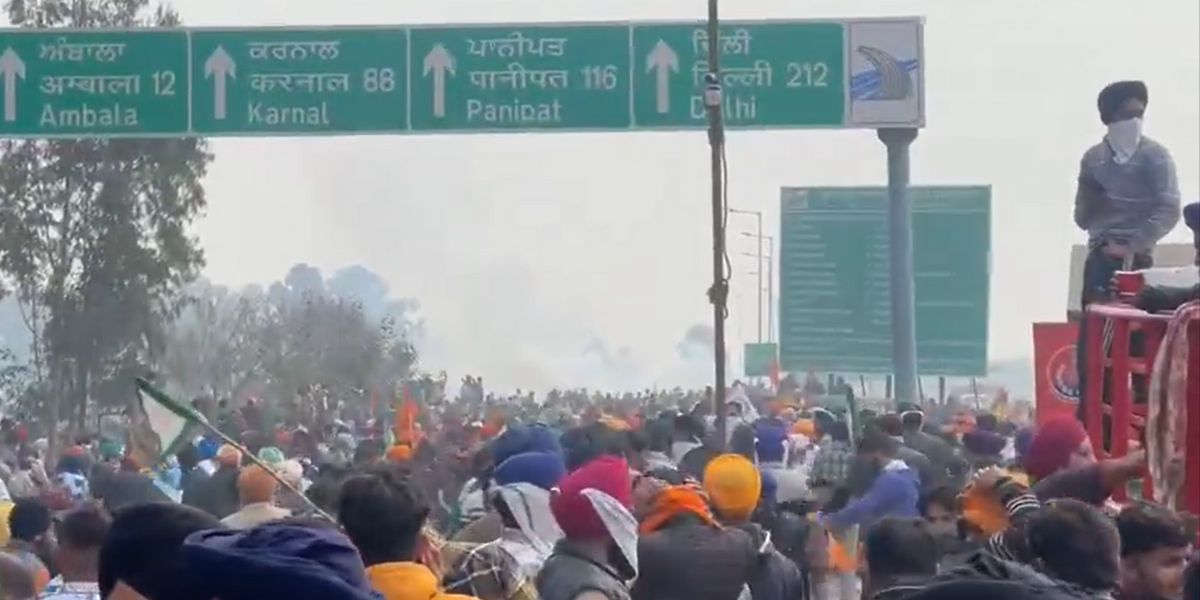The main beneficiaries of MSP based procurement of paddy and wheat are the farmers of Punjab and Haryana and not the southern states.

Farmers are being prevented from reaching Delhi. File. (Screengrab)
A large number of farmers, mainly from Punjab, Haryana, and parts of Uttar Pradesh, have again begun their aggressive protests demanding the central government to address their long pending demands, mainly ‘legal guarantee for the procurement of all crops at Minimum Support Price (MSP)’, as per the M S Swaminathan commission formula to consider the entire cost of cultivation of the crops including notional rent (if owned) plus 50% profit.
It is interesting and intriguing that the ongoing agitation is slightly different from the previous one, 2021, led, among others, by Rakesh Tikait.
The primary demand is for a legal guarantee of MSPs as per the Swaminathan Commission formula for all the 22 crops/commodities, which is tough to be acceded to by the Centre at ‘gunpoint’.
This requires inputs, views and acceptance from States/all stakeholders, impact on the exchequer and consequences on labour participation, productivity, competitiveness (local/global) and bearing on other crops.
This can eventually lead to a substantial financial burden on the central treasury, breed complacency amongst farmers, have huge ramifications in the agriculture sector and hurt feelings amongst farmers in different States who may not benefit under the MSP framework.
The ongoing ‘morcha’ is led by Samyukt Kisan Morcha and two other groups, which are Punjab and Haryana-centric, and a section of farmers from western Uttar Pradesh.
Small groups of farmers from Karnataka and Tamil Nadu did move towards Delhi to take part in the protest, though, like in the case of farmers from Karnataka, they were diverted to far-off places like Ujjain and Varanasi. Largely, farmers and unions representing the Southern states are not actively participating for the following reasons:
a) The main beneficiaries of MSP-based procurement of paddy and wheat are the farmers of Punjab and Haryana.
In 2022-23, under State-wise MSP, in wheat procurement, Punjab ranked first with 9.6 million metric tonnes with an MSP value of ₹19,378 crore and Haryana at 4.1 million metric tonnes at ₹8,256 crore. Contributions by the rest of the States were inconsequential and not affected by MSP.
b) Paddy procured under MSP during 2021-22 in Punjab was 18.7 million metric tonnes valued at ₹36,708 crore and 6.6 million metric tonnes valued at ₹12,844 crore in UP.
In the South, Karnataka was at meagre 219-kilo metric tonnes with an MSP value of ₹429 crore, Tamil Nadu 3.6 million metric tonnes valued at ₹7,101 crore, and Kerala was 704-kilo metric tonnes valued at ₹1,381 crore.
Telangana and Andhra Pradesh also take the MSP route for offloading their paddy produce through FCI and are quite comfortable with the agricultural reforms the respective State governments undertake.
c) The landholdings of farmers in Punjab and Haryana are quite huge, unlike in the Southern States, especially Karnataka and Tamil Nadu, which are subdivided and fragmented. Most of the poor and marginal farmers of southern states do not have the ‘sustenance’ power to agitate months together in New Delhi with rations stocked for months and away from their farms.
d) The cropping patterns also vary between the North and the South. Major crops grown in the southern States, like sugarcane, paddy, coffee, areca nut, cereals and pulses, pepper, and cardamom, are not directly impacted by the MSP, whether old or new.
Most of the produce is sold at a remunerative rate by the farmers directly at the respective APMCs, procured locally, for instance, by the consolidated coffee Boards or state governments procuring paddy or ragi produce at rates higher than the MSP.
e) In the southern states, the farming pattern is more labour-intensive, tenancy-driven with small holdings and more ‘attached’ to local associations like the ‘raitha sanghas’, which are mostly apolitical. In northern states farming is highly mechanised with huge land parcels and politically active and with better awareness of the pros and cons of the MSP.
f) In the event of famine or floods, which are predominant in the southern states, the state governments step in to procure the produce and ‘compensate’ for the losses, including farm loan waivers availed by the farmers from banks and local cooperative banks/societies.
g) The southern states traditionally give particular focus to agriculture, farmers and their requirements.
Even in the Karnataka budget presented on 16th February 2024, primacy was accorded to agriculture. Special schemes under ‘Raitha Samruddhi’, waiver of interest on medium- and long-term overdue loans of DCC and PICARD bank, which benefit 57,000 farmers and help the banks to recover ₹ 496 crore, were announced.
A special nodal agency — Agriculture Development Authority (ADA)– is being established under the chairmanship of the chief minister to monitor the implementation of agriculture policies, direct benefit transfers, and ensure the welfare of the farmers.
As such, there are no great benefits for these farmers to participate in agitation in far-off Delhi for months together, which invariably takes ‘political turns’ and raises affiliation issues with all corresponding risks.
(The author is a Bengaluru-based Banker, Economist and guest columnist.)

Jul 26, 2024

Jun 10, 2024

Jun 09, 2024

Jun 07, 2024

Jun 07, 2024

Jun 05, 2024